Beneath the threat of rain and planes passing overhead, a cohort of journalists walk the grounds of Etihad Park in Queens for the first time.
Executives from New York City Football Club are showing off the club’s new $780 million home as it begins to take shape. They walk through a maze of exposed beams and concrete, touting the venue’s most exclusive spaces. They point to the spaces where players’ locker rooms will be and a press box is being built.
Near the end of this hour-long tour, the executives point to the stadium’s southwest corner, where a seven-story cube will stand. This immersive entrance will be their centerpiece, greeting fans with thousands of LED screens as they enter the first soccer-specific stadium built in New York City. It’s “our version of the Las Vegas Sphere,” they say.
The venue’s pitch is currently a mix of dirt and rocks, surrounded by a skeleton of stands still under construction. While standing there, Jon Stemp, the chief infrastructure officer at City Football Group, which owns a majority stake in the MLS club, asks his audience to use its collective imagination.
Close your eyes, he says, and envision this spot in two years.
“Twenty-five thousand people in this stadium – roaring,” Stemp said. “Grass underfoot. The kickoff is going to take place here. This is going to be a very, very special place.”
This “Cathedral of Soccer,” as the club likes to say, is slowly rising.
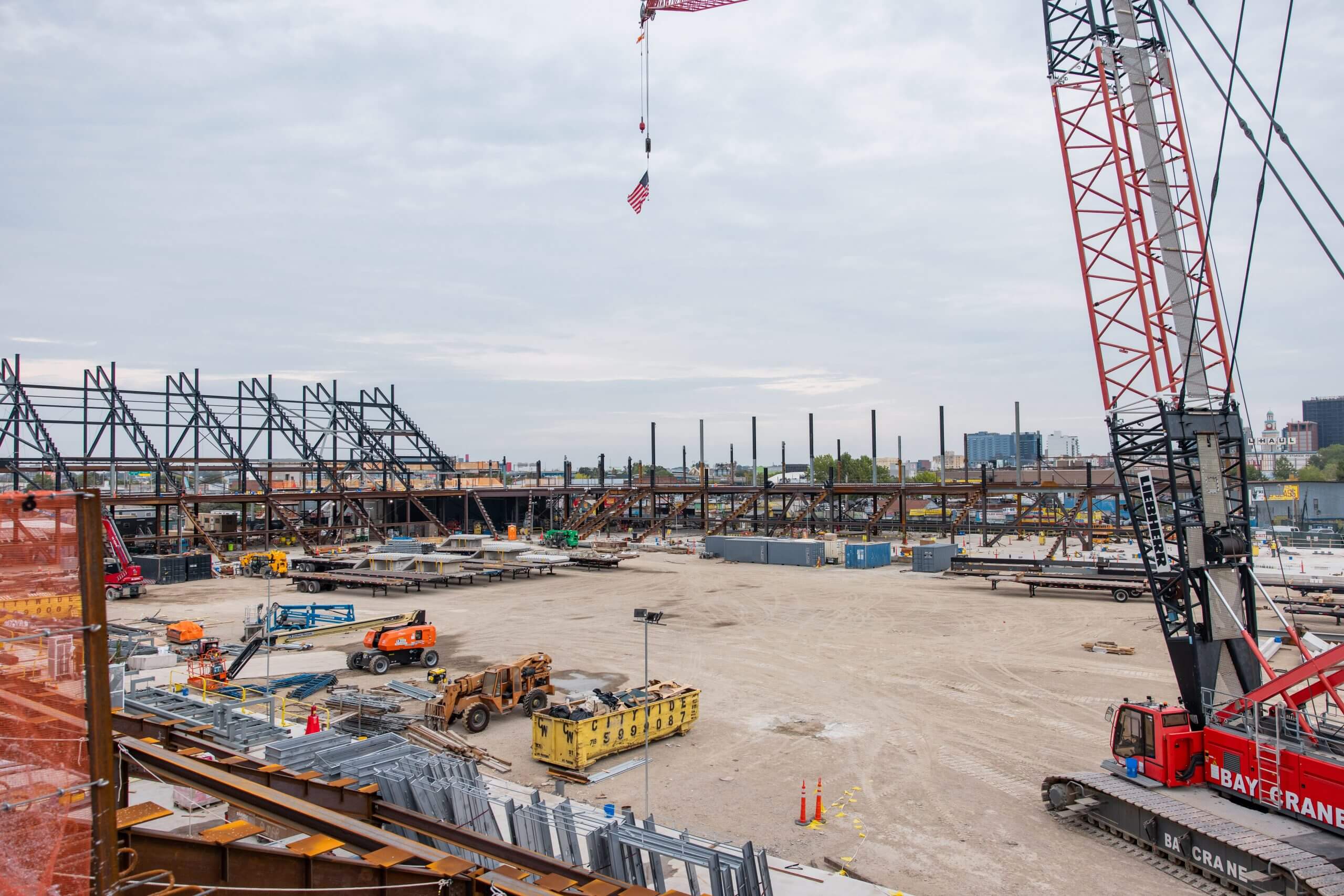
NYCFC’s Etihad Park is presently under construction (Melanie Anzidei)
While still an active construction site, buzzing with workers in hardhats and steel-toed boots, this moment has been 12 years in the making. An estimated 14,200 construction workers are bringing this dream to reality.
The MLS club has searched for a permanent home since its founding in 2013, bouncing between venues in the Tri-state area. For 2025, the club split its season between Yankee Stadium in the Bronx and Citi Field, the home of the Mets, in Queens.
For the 2025 regular season, NYCFC said it averaged 21,970 fans per match. That’s roughly half of the 40,085 fans at Citi Field for the club’s match against Inter Miami last month – an encouraging sign for the club, which has lofty ambitions of regularly selling out its new 25,000-seat venue come 2027.
Saturday afternoon, the team will host a first-round playoff game against Charlotte FC in the Bronx, but in past years, the location of home playoff games was an uncertainty and hinged on the availability of the local baseball stadiums – or, even worse, the home of the Hudson River rival New York Red Bulls. Suffice to say, the club is eagerly awaiting a place it can truly call its own.
“It’s tough to be a New York City FC fan, or employee, for the last 10-plus years,” Brad Sims, the club’s CEO, told The Athletic. “You’ve got to travel around. Don’t know where games are going to be. Our October 18th game, our Decision Day, arguably one of the most important games of the year, we didn’t know where that was going to be played.”
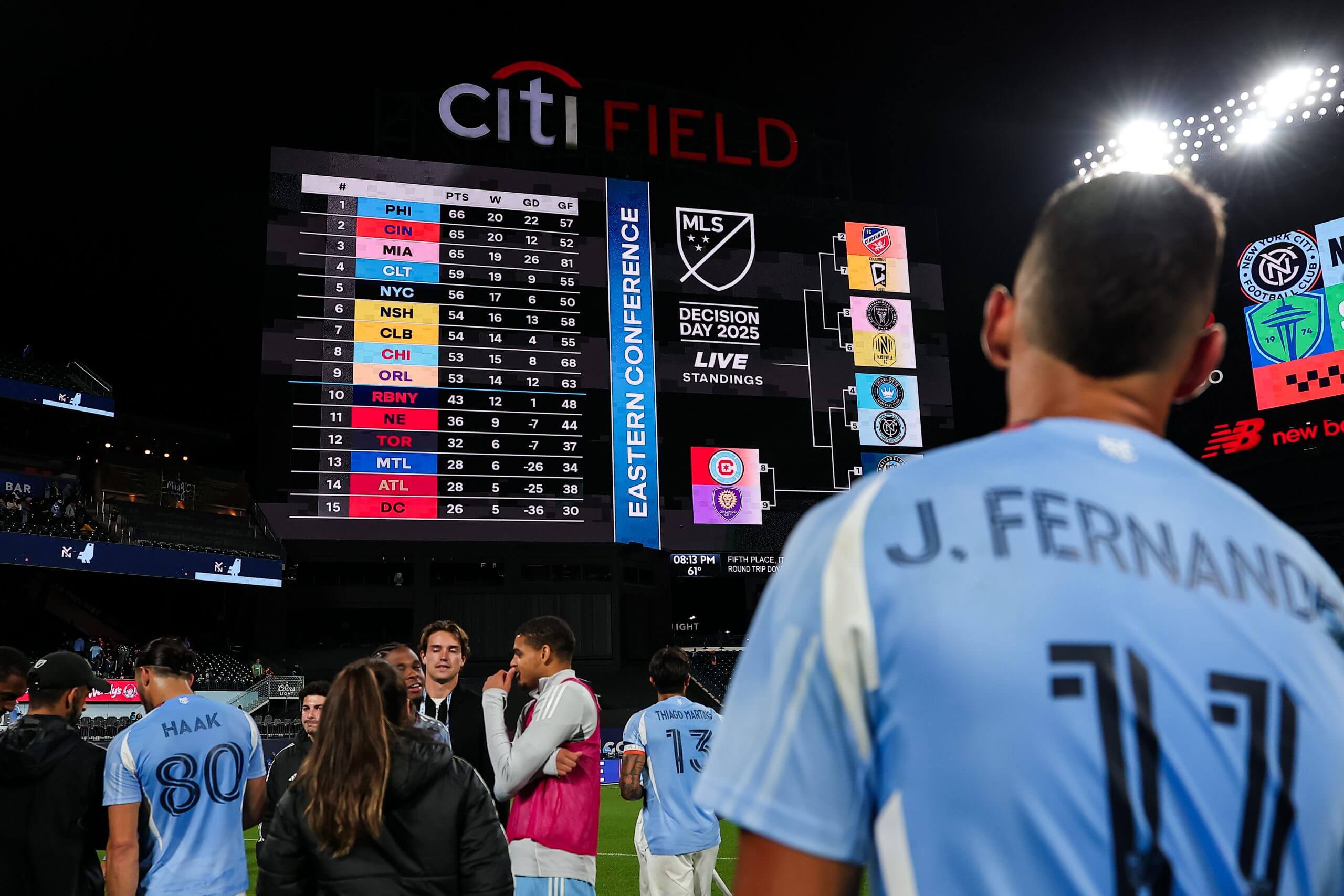
NYCFC played its 2025 Decision Day match vs. Seattle at Citi Field (Dustin Satloff / Getty Images)
That indecision and uncertainty now has an expiration date looming. Etihad Park is on track to open in 2027 – though the specific timing remains a moving target.
As The Athletic reported in July, MLS is considering flipping the season calendar to a fall-to-spring format. Doing so would align the league with FIFA and European calendars, allowing clubs better leverage in transfer windows. It would also move MLS playoffs into a more attractive part of the year for the league’s media partners, with most of the competition coming from the Stanley Cup playoffs, the NBA postseason and the start of the MLB season, under a new proposed format – as opposed to the NFL, college football and the World Series, as is currently the case.
This potential switch would be a welcomed wrinkle in NYCFC’s stadium plans.
“I feel like it wouldn’t be New York City FC if we didn’t have some kind of dynamic like that at play,” Sims said with a laugh, “I can’t get off the hook that easy.”
A calendar flip could change the construction timeline for Etihad Park, Sims said, with the club “very in favor” of that change happening as soon as 2027. The club said it stays in close contact with the league to discuss all possible scenarios.
“It would be perfect timing,” Sims said. With an MLS season starting in late July, “we would have more time to get the stadium up and running, and (can have) test events and concerts and international soccer friendlies leading into an MLS home opener.”
The latter is especially attractive, as global soccer continues to descend on the U.S. market, peaking with the 2026 World Cup and, a few years down the line, a 2031 Women’s World Cup.
“The global soccer world, come summertime every year, wants to be in the United States (on tour) – and if they want to be in the United States, New York City is definitely one of their key priorities.”
Sims envisions both U.S. men’s and women’s national teams becoming regulars at Etihad Park, in addition to clubs from around the world. NYCFC has been outspoken about having a full-time women’s team on site, too.
As a first of its kind in New York City, Etihad Park presents a unique opportunity, both to matchgoers and the offshoots that come from a stadium complex.
“There’s been nothing like this,” Stemp said. “Think of this (as a) Herculean lift, to come and put a soccer stadium in a city that’s never had one, at a time in New York when it’s notoriously difficult to get major development projects going.”
The stadium anchors a massive mixed-use redevelopment project in Willets Point.
This new neighborhood includes 2,500 units of affordable housing, a 250-room hotel and is expected to have restaurants and retail outlets. It will also have a 650-seat public elementary school and feature open space for public use. The residential buildings are further along than the stadium, with the development’s first units opening in April.
“We’re going from a situation, where we have, really, 17 days in the year (the number of MLS home games) to generate revenue, to having 365 days,” Sims said.
The club will have a team store open year-round at the stadium and anticipates the surrounding area to transform into a vibrant sports entertainment district in coming years, too.
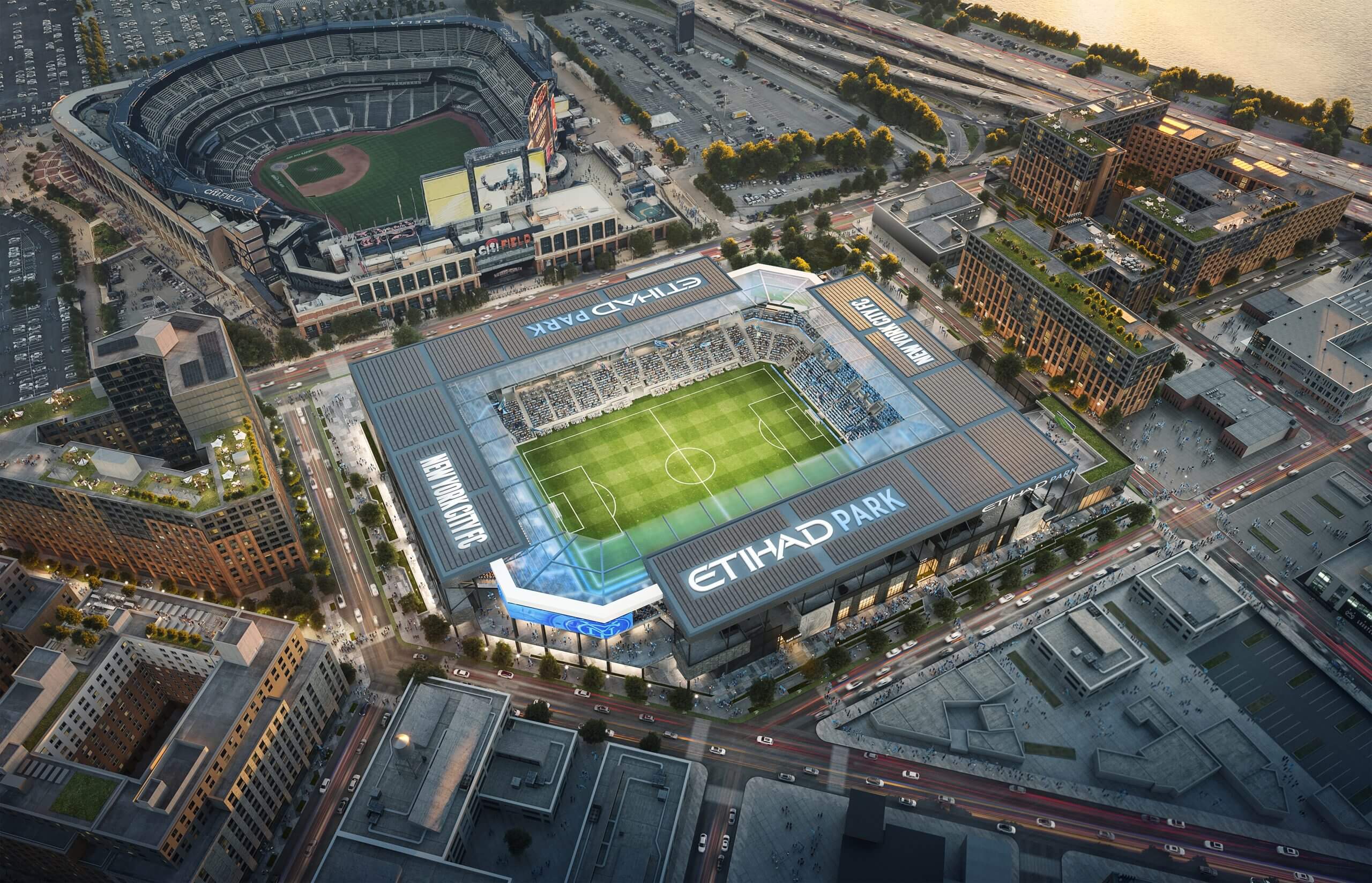
Etihad Park will be right across the street from the Mets’ Citi Field (Courtesy of NYCFC)
The USTA Billie Jean King National Tennis Center, home to the U.S. Open, is less than a mile away, and Citi Field is across the street. Mets owner Steve Cohen has been bullish on his proposal for an $8 billion casino at Metropolitan Park at Willets Point, which would further transform the evolving neighborhood.
For Francisco Moya, who grew up playing soccer in Flushing Meadows-Corona Park, watching Etihad Park come to life is special. A native of Corona, the Queens City Council member has long dreamed of seeing a professional soccer stadium in his borough.
“I have been documenting this since day one, when it was still junkyards,” Moya told The Athletic. “I consistently go every three months to see the progress. To see the housing that’s already done, it’s incredible. I get emotional, because it really is a legacy.
“To have the ability to take my passion and love for soccer and utilize it as a public policy tool, like, no one would have thought. But it’s something that has really worked to really provide for the neighborhood that raised me.”
The stadium will be all-electric, making it the first of its kind in MLS. It will also house the team’s main offices, with 120 employees relocating from Manhattan.
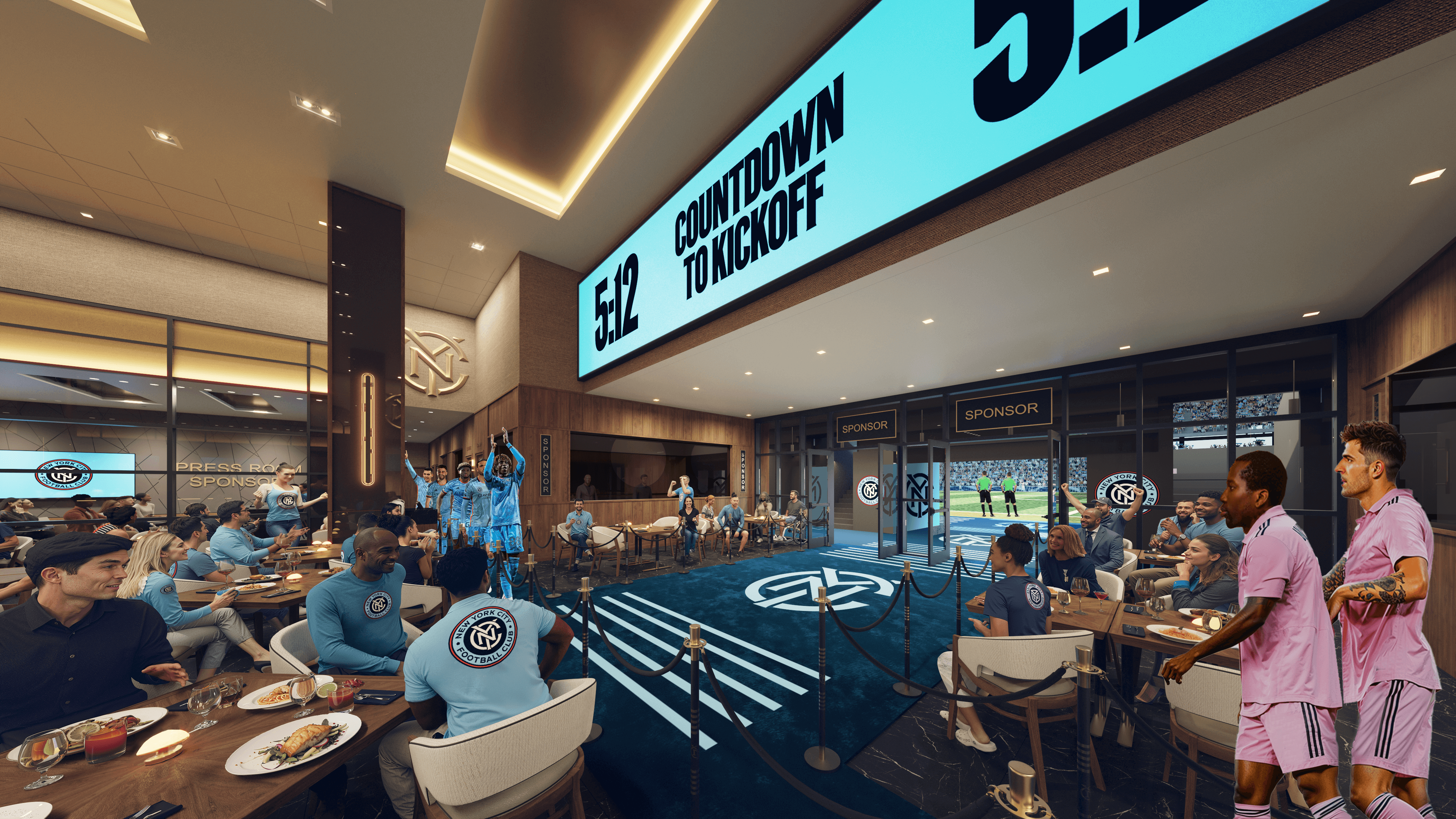
A rendering of Etihad Park’s Tunnel Club, where fans are in touching distance of players as they walk onto the field (Courtesy of NYCFC)
The “Tunnel Club,” which will seat 276 fans, is the venue’s most exclusive space, mirroring what already exists at Etihad Stadium, the home of NYCFC’s sister club Manchester City. Fans here will have a direct view of players as they walk onto the pitch and a front-row view of post-match press conferences, which will be enclosed by a glass wall. The latter is a popular feature that exists in other stadiums, including the NFL’s nearby MetLife Stadium.
The venue’s centerpiece remains “The Cube,” the seven-story entrance covered in more than 11,000 square feet of LED screens. The display will feature matchday programming, with the club saying it will unveil additional “surprise” plans for in the future.
“Imagine an eight-story Matt Freese making a diving save” as guests walk into the venue, Sims said.
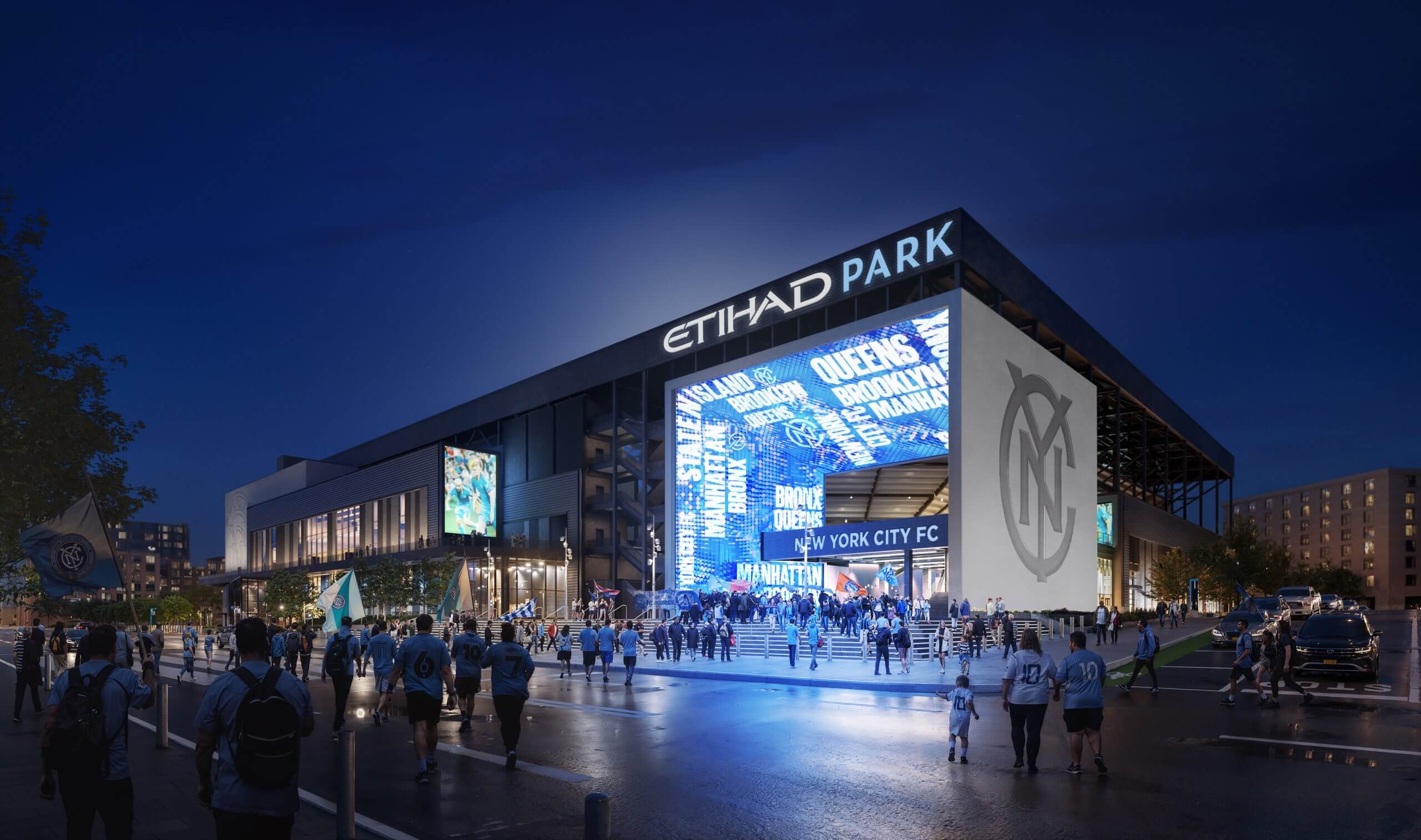
NYCFC’s stadium entrance is set to be a calling card of the new venue (Courtesy of NYCFC)
To build the stadium, the club had to prep the property before construction because the entire district was “sinking,” Stemp said. To remedy the issue, the club stabilized the grounds by driving 1,400 120-meter piles into the ground. It’s reminiscent of the prep work needed for other football stadiums around the world, including Everton’s new Hill Dickinson Stadium.
With stakes in or partnerships with 13 clubs, from its namesake club Manchester City to New York City FC and others in Australia, Italy and Uruguay, City Football Group has “plenty of experience on how to make pitches work in different parts of the world,” Stemp said.
Building in New York City, though, has been a “unique” challenge, he added.
Stemp envisions the grass being laid on the pitch around October 2026. The club has a “Plan A” and a “Plan B” for which type of grass it’ll use, with that decision, again, partially reliant on whether MLS flips the league calendar.
“The (MLS) season runs mostly through the summer, spring and summer. That could change, in which case, the grass will need to be able to operate through the winter.”
The pitch has undersoil heating to adapt for playoffs at the end of the calendar, regardless, Stemp said. So, “if there is a frozen pitch, we can still make sure it’s playable.”
“There’s lots of science going into the way it works, and it’s got to be flexible,” Stemp added, “because even though we’re designing for the opening season, we’ve got to make sure the building can adapt and evolve over the next 20, 30 years.”
Sims expects to be at Etihad Park more frequently as construction progresses. The stadium’s frame is now visible from the Van Wyck and Whitestone expressways – blocking drivers’ once-clear view of Citi Field.
But the club, at long last, has a clear vision of its future. There will be no need to wonder about where season openers or playoff games will be played. Over a decade later, NYCFC will have a home all to itself.

